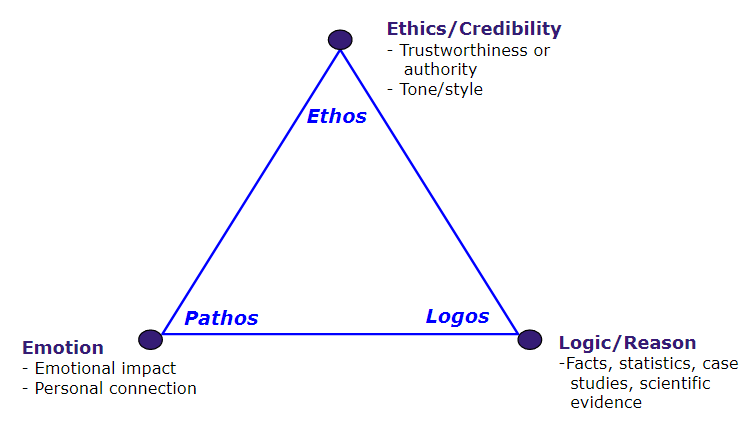8.5: The Rhetorical Triangle- Ethos, Pathos and Logos
- Page ID
- 83634
Thousands of years ago, Aristotle provided us with three ways to appeal to an audience, and they’re called logos, pathos, and ethos. You’ll learn more about each appeal in the discussion below, but the relationship between these three appeals is also often called the rhetorical triangle as shown in Figure 8.2. The idea is a persuasive message has all 3 of the points of a triangle. (As you can see, this is a very triangle-heavy chapter).

Pathos
Latin for emotion, pathos is the fastest way to get your audience’s attention. People tend to have emotional responses before their brains kick in and tell them to knock it off. Be careful though. Too much pathos can make your audience feel emotionally manipulated or angry because they’re also looking for the facts to support whatever emotional claims you might be making so they know they can trust you.
Many donations campaigns draw on pathos, such as this classic ASPCA ad:
Logos
Latin for logic, logos is where those facts come in. Your audience will question the validity of your claims; the opinions you share in your writing need to be supported using science, statistics, expert perspective, and other types of logic. However, if you only rely on logos, your writing might become dry and boring, so even this should be balanced with other appeals.
Ethos
Latin for ethics, ethos is what you do to prove to your audience that you can be trusted, that you are a credible source of information. (See logos.) It’s also what you do to assure them that they are good people who want to do the right thing. This is especially important when writing an argument to an audience who disagrees with you. It’s much easier to encourage a disagreeable audience to listen to your point of view if you have convinced them that you respect their opinion and that you have established credibility through the use of logos and pathos, which show that you know the topic on an intellectual and personal level.
You can also gain ethos through your use of sources. Reliable, appropriate sources act as expert voices that provide a perspective you don’t have. Layout, graphic design choices, white space, style and tone: all of these factors influence your ethos.
Fallacies
Regardless of what appeals you use in your writing, it is important to be aware of fallacies (errors in reasoning) because they can reduce the impact of your message on your reader. For more information on common fallacies, refer to these resources available from the Writing Commons:
- Logical fallacies: https://writingcommons.org/fallacious-logos
- Emotional fallacies: https://writingcommons.org/fallacious-pathos
- Ethical/credible fallacies: https://writingcommons.org/fallacious-ethos
Using Ethos, Pathos and Logos
According to Aristotle, a solid argument needed ethos, pathos and logos. That doesn’t mean that you should try to balance each one in every persuasive argument you make. Instead, ethos, pathos and logos help us do two things:
- Determine why an argument isn’t currently persuasive. For example, if you show a sample ad campaign to a client and they don’t find it trustworthy, you can examine how you’re using ethos. If your Powerpoint presentation is boring, you can think about how pathos could be used to help your audience take your message seriously.
- Identify how others are trying to persuade us: Ethos, pathos and logos can be useful tools for information literacy. When a salesperson comes into your office to give you a slick pitch about a new piece of software that’s going to change your working life, you can think about how they’re trying to persuade you. Is it all pathos with very few facts to back it up?
Practicing Ethos, Pathos and Logos
To practice your rhetorical triangle skills, see if you can identify how this vintagead for candy is using ethos, pathos and logos. It’s a little hard to read, so the hotspots repeat the text. (You’ll also notice that this ad is a product of its time. Would a candy ad for today ever have this much text?)
Image Description
Figure 8.2 image description: Starting at the top of the triangle, ethos, which is ethics and credibility; then, going counterclockwise pathos, which is emotion; and logos, which is logic and reason, are the three points in the rhetorical triangle.


